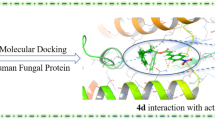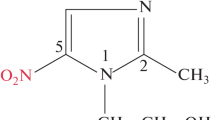Abstract
A series of sixteen curcumin derivatives (CURC-D) were designed and evaluated for their antibacterial/antifungal activity. POM analyses showed that lipophilicity and presence of (X–Y) pharmacophore site (X, Y = O, N) are the major factors that governed the orientation in determining antibacterial and/antifungal activity. Furthermore, it was also found that some of the POM analyzed CURC-derivatives have a closed pharmacophore sites which might be responsible of low bioactivity. To confirm the electronic, steric, and hydrophobic requirements for future modifications, we have also carried out receptor-based electrostatic analysis. Therefore, we conclude that POM analyses may prove to be a suitable method to correlate structural features of CURC-D with their promising combined antibacterial/antifungal activity and may contribute to the development of novel antimicrobial agents against drug-resistant human pathogens.
Graphical Abstract









Similar content being viewed by others
References
Aggarwal BB, Kumar A, Bharti AC (2003) Anticancer potential of curcumin: preclinical and clinical studies. Anticancer Res 23:363–398
Anand P, Sundaram C, Jhurani S, Kunnumakkara AB, Aggarwal BB (2008) Curcumin and cancer: an ‘‘old-age” disease with an ‘‘age-old” solution. Cancer Lett 267:133–164
Balogun E, Hoque M, Gong P, Killeen E, Green CJ, Foresti R, Alam J, Motterlini R (2003) Curcumin activates the haem oxygenase-1 gene via regulation of Nrf2 and the antioxidant-responsive element. Biochem J 371:887–895
Barik A, Mishra B, Shen L, Mohan H, Kadam RM, Zhang HY, Priyadarsini KI, Dutta S (2005) Evaluation of a new copper(II)–curcumin complex as superoxide dismutase mimic and its free radical reactions. Free Radic Bio Med 39:811–822
Cao H, Wang Y (2009) Fragmentation of isomeric intrastrand cross-link lesions of dna in an ion-trap mass spectrometer. J Am Soc Mass Spectrom 20:611–617
Chainani-Wu N (2003) Safety and anti-inflammatory activity of curcumin: a component of tumeric (Curcuma longa). J Altern Complement Med 9:161–168
Chattopadhyay I, Biswas K, Bandyopadhyay U, Banerjee RK (2004) Turmeric and curcumin: biological actions and medicinal applications. Curr Sci 87:44–53
Chohan ZH, Youssoufi MH, Jarrahpour A, Hadda TB (2010) Identification of inhibition: indolenyl sulphonamide derivatives. Eur J Med Chem 45:1189–1199
Dimroth O (1902) Mittheilungen Ueber eine Synthese von Derivaten des 1.2.3-Triazols. Ber Dtsch Chem Ges 35:1029–1038
Dimroth O (1909) Ueber intramolekulare Umlagerungen. Umlagerungen in der Reihe des 1, 2, 3-Triazols. Justus Liebig’s Annalen der Chemie 364:183–226
Dimroth O, Michaelis W (1927) Intramolekulare Umlagerung der 5-Amino-1,2,3-triazole. Justus Liebig’s Annalen der Chemie 459:39–46
Ertl P, Rohde B, Selzer P (2000) Fast calculation of molecular polar surface area (PSA) as a sum of fragment-based contributions and its application to the prediction of drug transport properties. J Med Chem 43:3714–3717
Gomez G, Mansouraty G, Gardea J, Narayan M (2007) Acceleration of oxidative protein folding by curcumin through novel non-redox chemistry. Biochem Biophys Res Co 364:561–566
Hadda TB, Akkurt M, Baba MF, Daoudi M, Bennani B, Kerbal A, Chohan ZH (2009) Anti-tubercular activity of ruthenium (II) complexes with polypyridines. J Enzym Inhib Med Chem 24:457–463
Hadda TB, Mouhoub R, Jawarkar R, Masand V, Warad I (2012a) POM analyses of antitrypanosomal activity of 2-iminobenzimidazoles: favourable and unfavourable parameters for drugs optimization. Med Chem Res. doi:10.1007/s00044-012-0238-0
Hadda TB, Fergoug T, Warad I (2012b) POM theoretical calculations and experimental verification of antibacterial potential of 5-hydroxy-4-(substituted-amino)-2(5H)-furanones. Res Chem Intermed. doi:10.1007/s11164-012-0729-0
Hadda TB, Ali MA, Masand V, Gharby S, Fergoug T, Warad I (2013) Tautomeric origin of dual effects of N1-nicotinoyl-3-(4′-hydroxy-3′-methyl phenyl)-5-[(sub)phenyl]-2-pyrazolines on bacterial and viral strains: POM analyses as new efficient bioinformatics’ platform to predict and optimize bioactivity of drugs. Med Chem Res 22:1438–1449
Jarrahpour A, Fathi J, Mimouni M, Hadda TB, Sheikh J, Chohan ZH, Parvez A (2012) Petra, osiris and molinspiration (POM) together as a successful support in drug design: antibacterial activity and biopharmaceutical characterization of some azo schiff bases. Med Chem Res 21:1984–1990
Kuhad A, Chopra K (2007) Curcumin attenuates diabetic encephalopathy in rats: behavioral and biochemical evidences. Eur J Pharmacol 576:34–42
Kuhar M, Imran S, Singh N (2007) Curcumin and quercetin combined with cisplatin to induce apoptosis in human laryngeal carcinoma Hep-2 cells through the mitochondrial pathway. J Cancer Mol 3:121–128
Lauria A, Abbate I, Patella C, Gambino N, Silvestri A, Barone G, Almerico AM (2008) Pyrazolo[3,4-d][1,2,3]triazolo[1,5-a]pyrimidine: a new ring system through Dimroth rearrangement. Tetrahedron Lett 49:5125–5128
Lin CL, Lin JK (2008) Curcumin: a potential cancer chemopreventive agent through suppressing NF-κB signaling. J Cancer Mol 4:11–16
Lopez-Lazaro M (2008) Anticancer and carcinogenic properties of curcumin: considerations for its clinical development as a cancer chemopreventive and chemotherapeutic agent. Mol Nutr Food Res 52:103–127
Maher P, Akaishi T, Schubert D, Abe K (2010) A pyrazole derivative of curcumin enhances memory. Neurobiol Aging 31:706–709
Parvez A, Meshram J, Tiwari V, Sheikh J, Dongre R, Youssoufi MH, Hadda TB (2010a) Pharmacophores modeling in terms of prediction of theoretical physicochemical properties and verification by experimental correlations of novel coumarin derivatives produced via Betti’s protocol. Eur J Med Chem 45:4370–4378
Parvez A, Jyotsna M, Youssoufi MH, Hadda TB (2010b) Theoretical calculations and experimental verification of the antibacterial potential of some monocyclic beta-lactames containing two synergetic buried antibacterial pharmacophore sites. Phosphorus Sulfur 185:1500–1510
Patel BB, Sengupta R, Qazi S, Vachhani H, Rishi AK, Majumdar APN, Yu Y (2008) Curcumin enhances the effects of 5-fluorouracil and oxaliplatin in mediating growth inhibition of colon cancer cells by modulating EGFR and IGF-1R. Int J Cancer 122:267–273
Rai D, Yadav D, Bamzarini J, De Clercq E, Singh RK (2008) Design and development of curcumin bioconjugates as antiviral agents. Nucleic Acids Symp 52:599–600
Ringman JM, Frautschy SA, Cole GM, Masterman DL, Cummings JL (2005) A potential role of the curry spice curcumin in Alzheimer’s disease. Curr Alzheimer Res 2:131–136
Rozhkov VY, Batog LV, Shevtsova EK, Struchkova MI (2004) Synthesis and Dimroth rearrangement of 3-amino-4-(5-amino-1H-1,2,3-triazol1-yl)-1,2,5-oxadiazoles. Mendeleev Commun 14:76–77
Sahu PK, Gupta SK, Thavaselvam D, Agarwal DD (2012) Synthesis and evaluation of antimicrobial activity of 4H-pyrimido[2,1-b]benzo. Eur J Med Chem 54:366–378
Santo RD, Costi R, Artico M, Tramontano E, Colla PL, Pani A (2003) HIV-1 integrase inhibitors that block HIV-1 replication in infected cells. Planning synthetic derivatives from natural products. Pure Appl Chem 75:195–206
Sharma OP (1976) Antioxidant activity of curcumin and related compounds. Biochem Pharmacol 25:1811–1812
Sheikh J, Hadda TB (2013) Antibacterial, antifungal and antioxidant activity of some new water-soluble b-diketones. Med Chem Res 22:964–975
Shen L, Ji HF (2007) Theoretical study on physicochemical properties of curcumin. Spectrochim Acta A 67:619–623
Shen L, Zhang HY, Ji HF (2005) A theoretical study on Cu(II)-chelating properties of curcumin and its implications for curcumin as a multipotent agent to combat Alzheimer’s disease. J Mol Struct THEOCHEM 757:199–202
Sui Z, Salto R, Li J, Craik C, Ortiz de Montellano PR (1993) Inhibition of the HIV-1 and HIV-2 proteases by Curcumin and curcumin Boron Complexes. Bioorg Med Chem 1: 415–422
Wongcharoen W, Phrommintikul A (2009) The protective role of curcumin in cardiovascular diseases. Int J Cardiol 133:145–151
Acknowledgments
The authors would like to extend their sincere appreciation to the Deanship of Scientific at King Saud University for its funding of this research through the Research Group Project no RGP-VPP-222.
Author information
Authors and Affiliations
Corresponding authors
Rights and permissions
About this article
Cite this article
Youssoufi, M.H., Sahu, P.K., Sahu, P.K. et al. POM analyses of antimicrobial activity of 4H-pyrimido[2,1-b]benzothiazole, pyrazole, and benzylidene derivatives of curcumin. Med Chem Res 24, 2381–2392 (2015). https://doi.org/10.1007/s00044-014-1297-1
Received:
Accepted:
Published:
Issue Date:
DOI: https://doi.org/10.1007/s00044-014-1297-1




